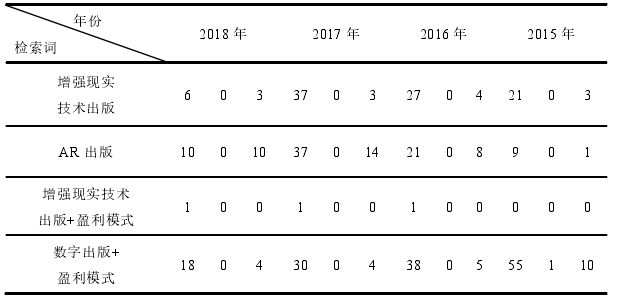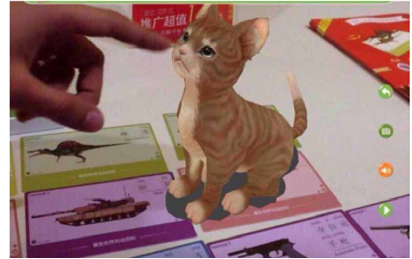The publishing industry relies on technology on a large scale. With itsdevelopment perspective, every major leap in the industry is inextricably linked tonew publishing technologies. With the further development of media integration andindustrial integration, the development of traditional paper publications has been introuble under the impact of the Internet and new media. For the content of publication,readers has a strong interest in innovating, modifying, and producing content. In thecase of traditional paper publications seeking to upgrade and transform, and toachieve a new way of multimedia convergence, it is necessary to solve the problemsof lack of advertising profit, low readers stickiness, and attenuation of publicitychannels.
As modern technology becomes more mature, augmented reality technology hasevolved from a conceptual technology to one of mature interactive technologies, andpractice in various fields is accelerating. In order to promote the transformation oftraditional paper publications to digital technology publishing, the use of augmentedreality technology can become a new multimedia publishing and interactivepublishing with audiences. Augmented reality technology has opened up a door to thepublishing industry, breaking through the concept of the line, realizing thecombination of traditional paper publications and connected new media, and the gapbetween online and offline has become shallower, realizing the expansion of the depthand breadth of the published content.
Starting from the five profit factors in the profit mode, this paper makes aninnovative research on the profit mode of augmented reality publications, andanalyzes many problems and shortcomings of the profit mode of augmented realitypublications in the publishing industry market. It has been analyzed and thought.
The first chapter mainly expounds the background and research significance ofthe whole paper, summarizes the domestic and international research status of theprofit mode of augmented reality publications, and introduces the whole researchideas and innovative research.
The second chapter is a conceptual definition of augmented reality publications,expounding its characteristics and development status. It also makes a conceptualanalysis of the profit mode of the paper's main augmented reality publication,summarizes the existing profit modes of the augmented reality technologypublications, and proposes to target the five profit factors in the profit mode.
The third chapter begins with the five profit factors of the profit mode andanalyzes the development dilemma of the profit mode of augmented realitytechnology publications. The simplification of the content format of publicationslimits the development of profit points; the target readers is not strong, which limitsthe expansion of profit sources; the marketing of publications is too weak, delayingthe formation of profit leverage; Insufficient scale effect hinders the establishment ofa profit barrier; the lack of innovation ability of the publishing house greatly weakensthe ability of profit organization.
The fourth chapter, in response to the development dilemma of the third chapter,makes corresponding countermeasures and suggestions. Enrich the content form ofthe publication, and develop diversified profit points; by enhancing the viscosity ofthe reader, it can expand the multi-level profit source; further explore the marketingmodel, develop multi-dimensional profit leverage; expand the scale effect of thepublication itself It is conducive to the creation of a personalized profit barrier;enhancing the innovation ability of the publishing house and ensuring the compositionof a comprehensive profit organization.
The fifth chapter summarizes the overall structure of the paper and expresses itsexpectation on the development of augmented reality publications.
Keywords: Augmented reality publications;Profit mode;Profit factor
目录
摘 要.............................................................................................................................. I
Abstract ........................................................................................................................ III
目录............................................................................................................................... V
第 1 章 绪论.................................................................................................................. 1
1.1 选题背景与研究意义...................................................................................... 1
1.1.1 选题背景............................................................................................... 1
1.1.2 研究意义............................................................................................... 2
1.2 国内外研究现状.............................................................................................. 2
1.3 研究思路和主要内容...................................................................................... 5
1.4 研究方法与创新之处...................................................................................... 5
第 2 章 增强现实技术出版物与盈利模式.................................................................. 6
2.1 增强现实技术出版物概述.............................................................................. 6
2.1.1 增强现实技术....................................................................................... 6
2.1.2 增强现实技术出版物解析................................................................... 7
2.1.3 增强现实技术出版物发展现状........................................................... 8
2.2 增强现实技术出版物应用特点...................................................................... 9
2.2.1 交互阅读:从平面媒体到全息媒体................................................. 10
2.2.2 超现实感:“平面+3D”的立体化 ...................................................... 10
2.2.3 内容扩展:提高产品附加值............................................................. 11
2.3 增强现实技术出版物盈利模式概述............................................................ 12
2.3.1 盈利模式解析..................................................................................... 12
2.3.2 增强现实技术出版物盈利模式发展现状......................................... 15
第 3 章 增强现实技术出版物盈利模式的发展困境................................................ 17
3.1 内容形式单一,限制利润点开发................................................................ 17
3.1.1 忽略受众需求,基础利润点单一..................................................... 17
3.1.2 交互设计生硬,期望利润点薄弱..................................................... 18
3.1.3 多元化意识低,附加利润点欠缺..................................................... 18
3.2 受众粘度不强,束缚利润源拓展................................................................ 19
3.2.1 推广模式单一,限制核心利润源的开发......................................... 19
3.2.2 终端成本高昂,束缚辅助利润源的拓展......................................... 20
3.2.3 多元思维欠缺,阻碍潜在利润源的挖掘......................................... 20
3.3 营销力度单薄,延缓利润杠杆形成............................................................ 21
3.3.1 内容同质化,营销杠杆支点偏斜..................................................... 21
3.3.2 平台过多化,渠道杠杆支点分散..................................................... 22
3.3.3 技术断层化,技术杠杆支点欠缺..................................................... 23
3.4 规模效应不足,阻碍利润屏障建立............................................................ 23
3.4.1 版权观念脆弱,版权效应屏障岌危................................................. 23
3.4.2 产业链不合理,规模效应屏障松动................................................. 24
3.4.3 平台建设缓慢,价值效应屏障脆弱................................................. 25
3.3.4 人才资源短缺,品牌效应屏障单薄................................................. 25
3.5 创新能力匮乏,削弱利润组织能力............................................................ 26
3.5.1 试错成本过高,利润组织形式受限................................................. 26
3.5.2 资金供给困境,利润组织结构受限................................................. 26
3.5.3 定位不够准确,利润组织关系混乱................................................. 27
第 4 章 增强现实技术出版物盈利模式的突围策略................................................ 28
4.1 丰富内容形式,开发多元化利润点............................................................ 28
4.1.1 丰富优质内容,巩固基础利润点..................................................... 28
4.1.2 改进技术手段,提升期望利润点..................................................... 29
4.1.3 增加多方投入,成就附加利润点.................................................... 30
4.2 增强受众粘度,拓展多层次利润源............................................................ 30
4.2.1 增加受众体验,开发核心利润源..................................................... 31
4.2.2 突出产品特性,拓展辅助利润源..................................................... 31
4.2.3 打破发展局限,挖掘潜在利润源..................................................... 33
4.3 挖掘营销方式,实现多维度利润杠杆........................................................ 34
4.3.1 扶正营销支点,实现产品的最优化................................................. 34
4.3.2 找准渠道支点,保证传播的最专化................................................. 35
4.3.3 筑就技术支点,达到服务的最精化................................................. 35
4.4 扩大规模效应,铸就个性化利润屏障........................................................ 36
4.4.1 构建版权体系,开发版权效应屏障................................................. 36
4.4.2 优化产业格局,提升规模效应屏障................................................. 37
4.4.3 完整平台建设,优化价值效应屏障................................................. 37
4.4.4 增加人才资源,发展品牌效应屏障................................................. 38
4.5 提升创新能力,夯实综合性利润组织........................................................ 39
4.5.1 善用众筹出版,丰富利润组织形式................................................. 39
4.5.2 多方平台合作,完善利润组织结构................................................. 40
第 5 章 结语................................................................................................................ 42
参考文献...................................................................................................................... 43
附录一.......................................................................................................................... 46
附录二.......................................................................................................................... 49
致谢.............................................................................................................................. 52
第 1 章 绪论
对于一种新的出版行业的出版模式的形成与发展,是需要多方面的后备力量,需要政策上的高度支持与技术成熟的运用等。因此,增强现实技术出版物拥有一个完善的商业模式,需要一个较长久的过程。
1.1 选题背景与研究意义
2016年***总书记在“科技三会”上的一个重要论断:“科技创新、科学普及是实现创新发展的两翼,要把科学普及放在与科技创新同等重要的位置。没有全民科学素质普遍提高,就难以建立其宏大的高素质创新大军,难以实现科技成果快速转换”。①因此,增强现实技术作为 “当下最受关注的十项新兴技术”
之一,为出版行业提供了一个新的方向,为受众感知及体验世界产生了一种全新的方式,也是目前数字板块的媒体技术与人工智能交互技术的一个重要的发展方向。增强现实技术的信息获取方式是虚拟内容在实体世界的真实体会,这使得出版行业中的内容出版呈现出一个新的选项。
1.1.1 选题背景
2016年5月10日,工信部中国电子技术标准化研究院和新华网联合征集了虚拟现实(VR)和增强现实(AR)国家及行业标准。2016年7月,国家新闻出版广电总局也开展了增强现实技术应用于新闻出版业的标准预研究课题,2016年12月,开展了增强现实技术应用于出版业的白皮书研究工作。②国家新闻出版广电总局数字出版司在2017年所启动的新闻出版企业数字化转型升级技术装备配置优化项目的支持采购装备中,也明确提出,新闻出版企业可以根据企业自身发展的实际情况,购置“知识服务支持工具系统、交互式在线学习/教育系统、增强/虚拟现实数字出版系统”等技术系统。
近些年来,国家在新型文化产业上加大了投入,又相继开展了专项资金等财政杠杆手段来表示支持,历年来投资超过了200多亿元,因此新型文化技术产业在大力扶持的国家政策下,在出版行业上实现增强现实技术出版物产业量化的发展提供了有力保障,也是增强现实技术出版物达到规模化发展的最主要的推动外力。
1.1.2 研究意义
增强现实技术出版物在出版行业的迅速发展中,存在相当多的问题,因此寻求最合适的增强现实技术出版的盈利模式显得格外重要。在出版行业的盈利模式中,一直不断讨论的话题有多方面组成,如出版版权保护意识不强烈,数字化概念不是很完善,利润的分配机制没有形成等,都是需要以一个成熟的盈利模式来解决的。因此在出版行业市场中,出版社谁能先掌握增强现实技术的盈利模式,就能先发夺人,掌握多的市场份额。①增强现实技术出版物目前还在其摸索阶段,成熟的盈利模式体系尚未构建完成,而拥有庞大出版内容资源的出版社缺乏技术的支撑,也少自主研究及创新的能力。论文旨在对现有的、成熟的数字出版的盈利模式同增强现实技术出版的现状进行对比分析,来构建更为良好的盈利模式。分别从出版内容、受众需求、技术渠道、版权价值及结构形式等几个方面来对应盈利模式的五个因子利润点、利润源、利润杠杆、利润屏障及利润组织来分析增强现实技术出版盈利模式的不足,并从相应角度给出意见和建议。对增强现实技术出版的盈利模式的探究提供参考价值,同时,希望能对增强现实技术出版物的发展起到一定的推动作用。②1.2 国内外研究现状 。
分别以“增强现实技术出版”、“AR出版”“增强现实技术出版+盈利模式”、“数字出版+盈利模式”作为“主题”、“关键词”、“篇名”进行联合检索,对中国知网下的文献进行检索,检索结果见表1-1。
表 1-1 文献检索情况③











